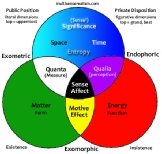



 NEXT
NEXT
 BACK
BACK
 Forum
Forum


Philosophical musings on Quanta & Qualia; Materialism & Spiritualism; Science & Religion; Pragmatism & Idealism, etc.





Multisense Information Realism
https://multisenserealism.com/thesis/a-
Post 80. April 20, 2019
Information : Shannon vs Deacon
Physical, Functional, Aesthetic
Originally, the word “information” referred to the meaningful software contents of a mind, which were assumed to be only loosely shaped by the physical container : the hardware brain. But in the 20th century, the focus of Information theory has been on its material form as changes in copper wires & silicon circuits & neural networks. Now, Terrence Deacon’s book about the Causal Power of Absence requires another reinterpretation of the role of Information in the world. He quotes philosopher John Collier, “The great tragedy of formal information theory [Shannon] is that its very expressive power is gained through abstraction away from the very thing that it has been designed to describe.” Claude Shannon’s Information is functional, but not meaningful. So now, Deacon turns the spotlight on the message rather than the medium.
He points out an unintended consequence of the statistical definition of Information, “By stripping the concept of its links to reference, meaning, and significance . . . The result is that the technical use of the term information is now roughly synonymous with difference, order, pattern, or the opposite of physical entropy. . . . This redefinition of the concept of information as a measure of order has, in effect, cemented the Cartesian cut into the foundation of physics. . . . implicitly support the claims of both eliminativism1 and panpsychism2.” Deacon prefers to avoid those thought-
Deacon addresses many of those self-
Deacon’s contribution to the science of Information might be labeled Aesthetics (interactive participation with the world), since it goes beyond Functional & Physical , into the realm of sensation, perception, opinion, and intention. Those three categories are explored further in theories of Multisense Information Realism. [see note at right] Conventionally, “aesthetics” is the science of beauty & ugliness. But it originally referred to sensations & responses, inputs & outputs, feelings & opinions.
Post 80 continued . . . click Next

Incomplete Nature
How Mind Emerged From Matter
by Terrence Deacon (2011)
Professor of biological anthropology & neuroscience
“It offers a figure/background shift that shows how even meanings and values can be understood as legitimate com-
https://www.amazon.com/Incomplete-
1. Eliminativism :
A materialist theory of mind which denies spiritual theories of mind as functions of a supernatural soul.
2. Panpsychism :
The philosophical position that everything in the world, including matter, has some element of consciousness.
3. Meaning in the gaps :
Deacon’s notion of Causal Absence, if true, could help explain, not only the apparent absence of G*D in the world, but also the unreasonable efficacy of intangible ideas in the physical world. Such brain-
Regarding the “God of the Gaps” pejorative, see the Blog Forum post on that Quora Forum topic :
4. Mental Mysteries :
Bernardo Kastrup, in his book, The Idea of the World, argues the “advantages of idealism over physicalism, especially in the face of contextuality in quantum physics, the ‘hard problem’ of consciousness, and the subject combination problem in philosophy of mind”.
https://www.bernardokastrup.com/



Multisense Information Realism
Physical Substantiation +
Functional Information +
Aesthetic Participation =
Multisense Realism
“If we throw in QM and get a whole other idea of information and physics, where physics itself is pure information. I sympathize with the effort to unify under something like pattern or information, but ultimately it fails to explain how or why information would make up its mind to pretend to be the universe. It’s kind of a mess, and I think it takes us away from the more relevant issue of information’s direct relation to consciousness (sense) and conscious-